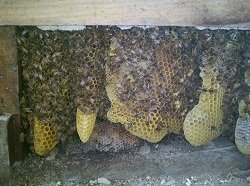Using a Honey Extractor to Harvest Honey
A honey extractor producing the liquid gold from the honey bee is one of the greatest joys of beekeeping. Working your bees to produce this unique food product is definitely rewarding.
So how do you use the extractor to harvest your honey?
The two frame honey extractor we used in harvesting honey this year belongs to our beekeeping association. If your extractor doesn't have a stand, you will need to figure out a way to stabilize it during the extraction process. I have my Dad's old Black & Decker Workmate. It made the perfect stand for the extractor.
Once you have an extractor, get your honey frames from your hive. This is one time you will open your hive that you shouldn't smoke your bees much. Smoking taints the flavor of your honey. [You will probably have a greater urge to smoke your bees during this visit, because they generally aren't happy when you are robbing their hive.]
There are several methods to getting the bees off the frames of honey so you can take them to your honey processing area without bees. [This is one of the few times when you as a beekeeper will want to be separated from your bees!]

After gleaning all your frames of honey, it's time to head to the processing area to get the honey out of your frames.
Hopefully you have a capping knife to melt/cut off the caps from your frames. You can use a regular knife for this, but care must be taken, even with a heated capping knife not to tear the wax from the foundation.
After the caps are removed the frames are placed in the extractor. where they are spun out. The extractor we used was a two frame hand operated honey extractor.
Spin the frames until the honey is extracted from one side, about 75 - 100 cranks at a pretty high speed. Take care with wired wax foundation to be sure you don't cause the foundation to come apart.
After 5 or 6 frames we had to open the honey gate at the bottom to begin draining off honey into the waiting bucket with the filter screen tied off on the the top.
After all the frames had been extracted and the honey extractor drained, the cappings were added to the filter in the top of the bucket so the honey on them to be recovered.
Let your honey rest in the bucket for 24 hours so bubbles can rise to the top. In the mean time prepare your jars & labels to receive your liquid gold for personal consumption and to sale.
List your favorite or find a new one to try!


If you see bees going in and out of a structure, you may be in for a surprise as to what is behind the wall.